Dr. Poesch’s paper on climate change impacts to freshwater fishes was featured in the Spring 2017 issue of Renew.
Link to pdf: Renew_Spring_2017
Link to paper on “Climate change impacts on freshwater fishes: A Canadian perspective“.
My research focuses on issues related to aquatic biodiversity, including: conservation of freshwater fishes (e.g. species at risk, invasive species), sustainable resource development and developing robust restoration and reclamation activities. My goals are to: build effective collaborations across Alberta and North America; to train the next generation of research leaders; to provide an atmosphere of respect and learning; to engage the public and stakeholders; and, to develop leading edge novel research to solve applied problems.
Dr. Poesch’s paper on climate change impacts to freshwater fishes was featured in the Spring 2017 issue of Renew.
Link to pdf: Renew_Spring_2017
Link to paper on “Climate change impacts on freshwater fishes: A Canadian perspective“.
Abstract:
Understanding the movement ability and the spatial scale(s) of population genetic structure of species can together better ‘tune’ management objectives to prevent potential range contraction and population declines. We studied the Rocky Mountain Sculpin (Cottus sp.), a threatened species in Canada, to demonstrate the utility of using two complementary approaches to assess connectivity of a species. To do so, we used Passive Integrated Transponder (PIT) tags with a stationary tracking array (n = 223) to track movement and genetic data (n = 1,015) from nine microsatellite loci to assess genetic population structure. The PIT tag results indicated that Rocky Mountain Sculpin are sedentary; approximately 50% of individuals only moved a maximum distance of 10 meters (upstream or downstream) over a 5-month period. Genetic analyses indicated that at the spatial scale of our study area (5500 km2), watershed structure (river basins) is the main geographic feature influencing population genetic structure. We used the Bayesian clustering tool STRUCTURE, which suggested four distinct sub-populations of Rocky Mountain Sculpin in Canada. Genetic structure at finer spatial scales (within basins and sub-basins) appears to be influenced by fluvial distance (i.e., geographic distance along a river) and elevation change between sample locations (i.e., isolation-by-distance and isolation-by-environment). Combining movement and genetic analyses provides complimentary evidence of limited dispersal in Rocky Mountain Sculpin and highlights that both approaches together can provide broader insight into connectivity between populations that may ultimately help to aid future management decisions.
Citation: Ruppert, J.L.W.*, James, P.M.A., Taylor, R., Rudolfsen, T.*, Veillard, M.*, Davis, C., Watkinson, D. and Poesch, M.S. 2017. Riverscape genetic structure of a threatened and dispersal limited freshwater species, the Rocky Mountain Sculpin (Cottus sp.). Conservation Genetics 18: 925-937.
STRUCTURE results showing mean assignment of individuals into four clusters and sorted by geographic locatoins. Geographic locations are abbreviated as FH: Flathead River, LC: Lee Creek, STM: St Mary River and NM: North Milk River.
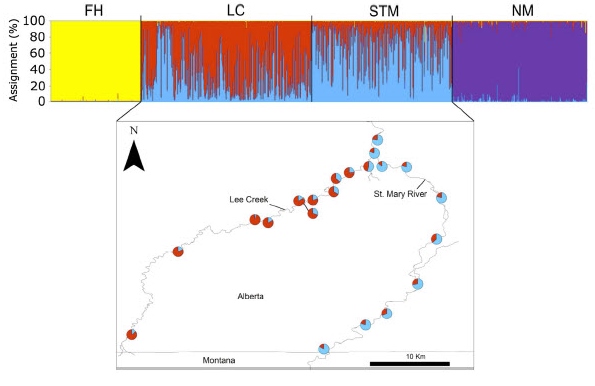
Also Read:
*Lab members: Jonathan Ruppert, Tyana Rudolfsen, Marie Veillard, Mark Poesch. Check out opportunities in the lab!
Dr. Poesch described the role of fish species at risk in the Anthropocene.
Abstract:
We developed a spatially explicit simulation model of poaching behaviour to quantify the relative influence of the intensity, frequency, and spatial distribution of poaching on metapopulation viability. We integrated our model of poaching with a stochastic, habitat-based, spatially explicit population model, applied it to examine the impact of poaching on northern abalone (Haliotis kamtschatkana) metapopulation dynamics in Barkley Sound, British Columbia, Canada, and quantified model sensitivity to input parameters. While demographic parameters remained important in predicting extinction probabilities for northern abalone, our simulations indicate that the odds of extinction are twice as high when populations are subjected to poaching. Viability was influenced by poaching variables that affect the total number of individuals removed. Of these, poaching mortality was the most influential in predicting metapopulation viability, with each 0.1 increase in mortality rate resulting in 22.6% increase in the odds of extinction. By contrast, the location and spatial correlation of events were less important predictors of viability. When data are limited, simulation models of poaching combined with sensitivity analyses can be useful in informing management strategies and future research directions.
Citation: Camaclang, A.E., Curtis, J.M.R., Poesch, M.S., and M.A. Koops. 2017. Modelling the impact of poaching on metapopulation viability for data-limited species. Canadian Journal of Fisheries and Aquatic Science 74: 894-906.
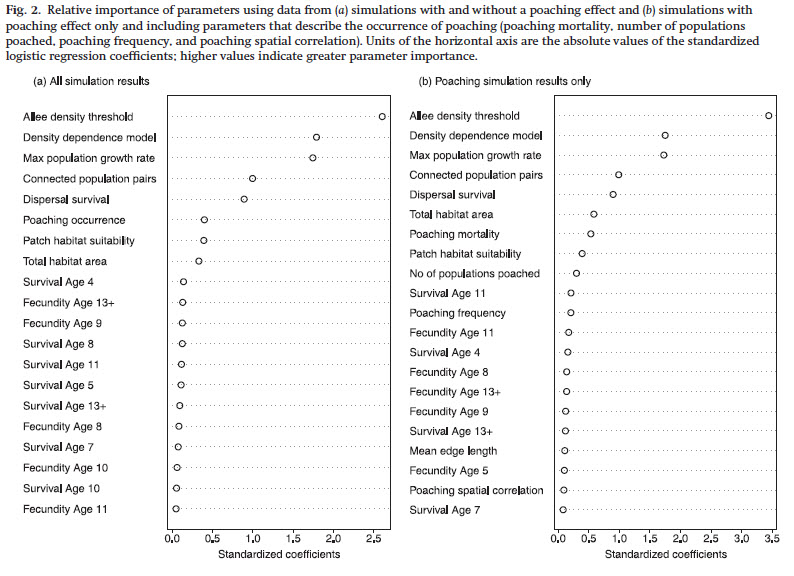
Also Read:
Abstract:
Stream crossing structures are an increasingly prevalent anthropogenic feature on North American riverscapes, particularly in watersheds affected by industrial resource development in sensitive boreal environments. If improperly managed, stream crossings have the potential to alter fish habitat and impede fish movement. This study assessed instream habitat characteristics and fish communities from 33 culverted, bridged and reference streams in an industrialising region of the boreal forest in west-central Alberta. Mixed-effects modelling and multivariate analysis were used to determine impacts of stream crossings at three scales: whole-stream scale, within-stream scale and the interaction of scales. Instream habitat characteristics such as mean depth, water velocity, percent fines, turbidity, water temperature and dissolved oxygen showed significant between-stream as well as within-stream differences among stream crossings. The majority of fish species exhibited significantly lower densities (n m−2) in upstream habitats as compared to downstream habitats, including a significant reduction in Slimy Sculpin densities in culverted streams. Multivariate tests corroborated these results, showing that fish assemblages differ as a function of stream type. This study suggests industrial stream crossings influence abiotic habitat characteristics in freshwater ecosystems, restrict biotic connectivity and impact fish community structure at the whole-stream and within-stream scales. Alterations to stream ecosystems associated with stream crossings may be driving large-scale changes in stream fish communities in the boreal forest. With expanded development expected in much of North America’s boreal region, mitigation measures which limit impacts from stream crossings are needed to ensure proper ecosystem function in freshwater systems.
Citation: Maitland, B.M.*, Anderson, A. and Poesch, M.S. (2016) Prioritising culvert removals to restore habitat for at-risk salmonids in the Boreal forest. Fisheries Management and Ecology 23: 489-502.
Site Locations of Assessed Stream Crossings, including (a) Simoneete, (b) Latronell and (c) Deep Valley watersheds in Alberta Canada.
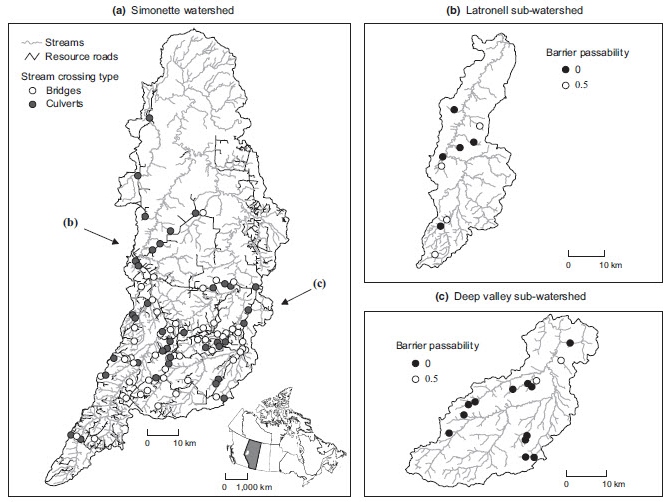
Prioritization given: net habitat gain (a,d), number of barriers removed (c,f) and the mean cost per barrier (c,f) across Deep Valley and Latronell subwatersheds.
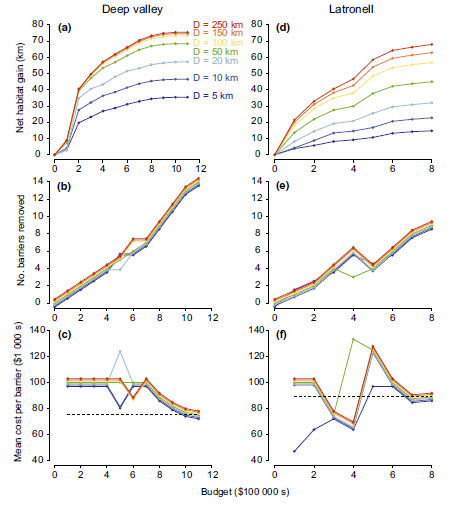
Also Read:
*Lab members: Bryan Maitland, Mark Poesch. Check out opportunities in the lab!
Abstract:
Current and projected patterns of global climate change are a major concern to freshwater fisheries in Canada. The magnitude of the impacts of climate change vary among species and ecoregions. The latest climate change scenario projections for Canada suggest that by 2050 temperatures will increase between about 4.9°C ± 1.7°C (average mean ± standard deviation) and 6.6°C ± 2.3°C under the Representative Concentration Pathways (RCPs) 2.6 and 8.5 emission scenarios, respectively. These changes will have an important influence on the physiology, distribution, and survival of freshwater fishes, as well as other ecological processes in direct, indirect, and complex ways. Here we provide a perspective from the Canadian Aquatic Resources Section on the impacts of climate change to freshwater fishes. Given the geographic size and diversity of landscapes within Canada, we have divided our perspective into three regions: eastern, western, and northern Canada. We outline the impacts of climate change to these regions and outline challenges for fisheries managers. Because climate change does not operate in isolation of other environmental threats, nor does it impact species in isolation, we suggest improved inter jurisdictional integration and the use of an adaptive and ecosystem-based approach to management of these threats.
Citation: Poesch, M.S., Chavarie, L., Chu, C., Pandit, S.N.*, and W. Tonn. (2016) Climate change impacts on freshwater fishes: A Canadian perspective. Fisheries 41(7): 385-391.
List of species that have potential to extend their range and/or abundance northward into the Arctic, with some biological characteristics related to expansion of their existing ranges.

Also Read:
*Lab members: Shubha Pandit, Mark Poesch. Check out opportunities in the lab!
Citation: Neufeld, K.*, Watkinson, D., and Poesch, M.S. (2016) The effect of hydrologic alteration on capture efficiency of freshwater fishes in a highly modified Prairie stream: Implications for bio-monitoring programs. River Research and Applications 32: 975-983.
Abstract
Hydrology is a defining feature of aquatic ecosystems. Changes in stream hydrology, due to climate change, water use and impoundment, have been shown to negatively affect fish populations. Assessing changes in hydrology and its effect on fish populations and communities remains an important consideration for aquatic monitoring programmes across the globe. In this study, we used the Milk River in southern Alberta as a model system to understand how hydrologic alteration may also affect capture probabilities of fishes and impact instream monitoring programmes. The Milk River receives the majority of its April to October flow via an inter-basin transfer from the St. Mary River, drastically altering the hydrologic regime and instream habitats for fishes during this augmentation period. We estimated species-specific seine net capture probabilities of fishes in the Milk River during augmentation and natural flow periods using depletion surveys in both open and enclosed sites. Using habitat data collected during the seine surveys, linear mixed-effects models were created with capture efficiency as the dependent variable. Models were compared using corrected Akaike’s information criterion, and the relative contributions of the different variables to the top models were examined. We found that species and flow characteristics, such as water velocity and the state of augmentation, played a prominent role in many of the top models explaining variation in capture efficiency. These results demonstrate that changes to stream hydrology clearly have the potential to impact gear efficiency and individual species assessments. Stream monitoring programmes, which aim to determine long-term trends in aquatic ecosystem health, need to be mindful that any change to stream hydrology—from climate change, fragmentation or stream alteration—can alter capture efficiency of the sampling gear and inadvertently alter species-specific trends.
*Lab members: Kenton Neufeld, Mark Poesch. Check out opportunities in the lab!
Seine net capture probability for Flathead Chub, Longnose Dace, Sucker species, and Western Silvery Minnow in the Milk River in southern Alberta during augmented and natural flow conditions, and from open and closed surveys.

Abstract:
Visible implant tags are commonly used in fisheries research to mark individuals or batches of fish as part of movement and mark–recapture studies. To be effective, these tags generally need to have high retention rates and little impact on the behavior or physiology of the marked individuals. We tested the retention rates of both visible implant elastomer (VIE) and visible implant alphanumeric (VIA) tags in 80–139-mm Western Silvery Minnow Hybognathus argyritis over a 104-d period. We also measured plasma cortisol and lactate to determine the impact of tagging on stress levels. We found that VIE tags had 100% retention and did not cause a significant increase in plasma cortisol levels, though plasma lactate levels were elevated in VIE treatment groups. Overall, VIE tags were found to be suitable for marking Western Silvery Minnow and similar species. Visible implant alphanumeric tags had 36% retention over 104 d and did not cause significant increases in plasma cortisol, though plasma lactate was elevated in the treatment group with both VIE and VIA tags. Given the high retention rates and low stress effects, VIE tags appear to be more beneficial for use with Western Silvery Minnow and similar-sized cyprinids.
Citation: Neufeld, K.*, Blair, S., and Poesch, M.S. 2015. Retention and stress effects of visible implant tags when marking Western Silvery Minnow Hybognathus argyritis and its application to other cyprinids (family Cyprinidae). North American Journal of Fisheries Management 35: 1070-1076.
Average Western Silvery Minnow (a) plasma cortisol and (b) plasma lactate concentrations for the various tagging treatments (VIE – Visual Implant Elastomer, VIA – Visual Implant Alpha, VIE+VIE – both) for days 1, 54 and 103/104. Error bars represent SD.
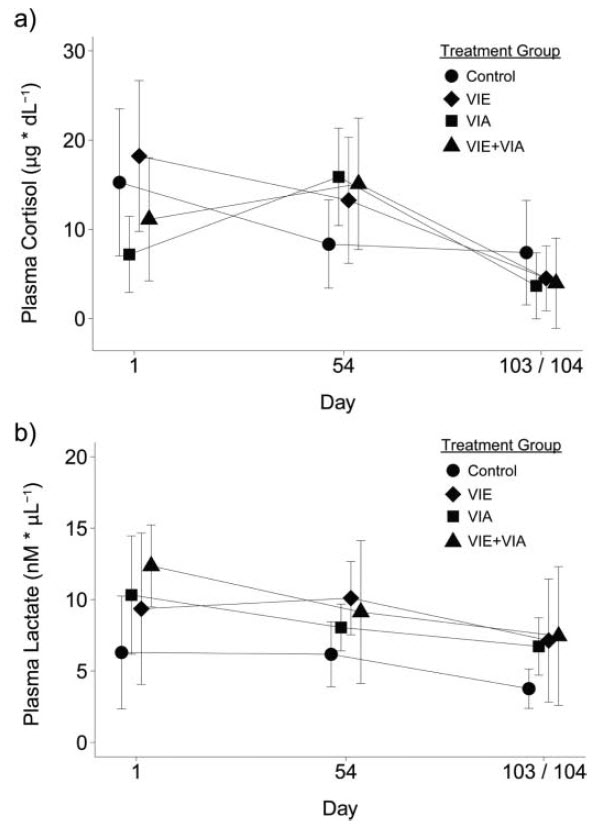
Also Read:
*Lab members: Kenton Neufeld, Mark Poesch. Check out opportunities in the lab!
Citation: Maitland, B.*, Cooke, S. and M.S. Poesch. 2015. Finding the path to a successful graduate and research career: Advice for early career researchers. Fisheries 40: 399-403.
Abstract
The path to a successful graduate and research career is a complex and difficult one. Early career researchers (ECRs) have myriad choices and tasks to prioritize and complete as they build their CV but are often confronted with unfamiliar situations in which advice from more senior researchers can be extremely valuable. Here, we summarize a recent workshop held for ECRs by the Canadian Aquatic Resource Section of the American Fisheries Society (AFS) with support from the Education Section. Sessions touched on (1) getting published, (2) science communication and outreach, (3) scoring a job or grad school position, and (4) working within the science–policy interface. The decades of collective experience brought to the table should be shared with the broader readership of AFS because it may prove useful to ECRs as well as stimulate meaningful conversations on these important and timely issues.
*Lab members: Bryan Maitland, Mark Poesch. Check out opportunities in the lab!
Abstract:
Functional diversity indices have become important tools for measuring variation in species characteristics that are relevant for ecosystem services. A frequently used dendrogram-based method for measuring functional diversity, ‘FD’, was shown to be sensitive to methodological choices in its calculation, and consensus methods have been suggested as an improvement. The objective of this study was to determine whether consensus methods can be used to reduce sensitivity when measuring FD. To calculate FD, a distance measure and a clustering method must be chosen. Using data from three natural communities, this study demonstrates that consensus methods were unable to resolve even simple choices of distance measure (Euclidean and cosine) and clustering method (UPGMA, complete and single linkage). Overall, there was low consensus, ranging from 41–45%, across choices inherent in functional diversity. Further, regardless of how FD was measured, or how many species were removed from the community, FD closely mirrored species richness. Future research on the impact of methodological choices, including choices inherent in producing a dendrogram and the statistical complications they produce, are needed to move functional diversity metrics forward.
Citation: Poesch, M.S. 2015. To dendrogram or not? Consensus methods show that the question needed to move functional diversity metrics forward. Ideas in Ecology and Evolution. 8: 70-74.
Also Read: